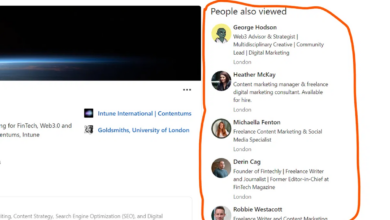
Micro Influencer Marketing A Deep Dive
Micro influencer marketing sets the stage for a compelling exploration of this burgeoning field. It’s more than just another marketing tactic; it’s a nuanced strategy that leverages the power of authentic voices and targeted engagement. We’ll delve into defining micro-influencers, identifying ideal audiences, crafting successful strategies, and analyzing campaign performance, culminating in case studies and future trends.
This comprehensive guide will unpack the key elements of micro influencer marketing, from understanding the different types of micro-influencers and their unique characteristics to the methods of identifying and collaborating with them. We’ll cover content creation, collaboration agreements, and the crucial steps to measure and analyze campaign effectiveness. Ultimately, this exploration will provide a roadmap for brands looking to leverage this impactful marketing approach.
Defining Micro-Influencer Marketing

Micro-influencer marketing is a strategic approach to leveraging social media influence, focusing on individuals with smaller but highly engaged audiences. Unlike mega-influencers with millions of followers, micro-influencers cultivate a loyal following within specific niches. This approach often yields higher engagement rates and more authentic connections, making it a powerful tool for targeted campaigns.This approach offers a unique opportunity to connect with audiences on a deeper level.
By partnering with micro-influencers, brands can tap into communities of like-minded individuals who are more receptive to recommendations and product endorsements from trusted voices. This targeted engagement fosters a sense of authenticity that resonates strongly with today’s consumers.
Micro-Influencer Definition
Micro-influencers are individuals who have a smaller, yet highly engaged audience, compared to macro or mega-influencers. They possess a specialized knowledge or passion in a particular niche, fostering trust and credibility among their followers. Their audience engagement tends to be substantially higher than that of broader-reach influencers, making them ideal for building genuine connections.
Key Characteristics of Micro-Influencers
Micro-influencers are characterized by their:
- Niche Expertise: They possess a deep understanding of a specific area, often exceeding general knowledge. This expertise translates to valuable insights and authentic recommendations, resonating with their dedicated audience.
- High Engagement Rates: Micro-influencers often maintain a strong relationship with their followers, resulting in higher interaction rates compared to those with broader followings. This higher engagement translates to greater impact on marketing campaigns.
- Authenticity and Trust: Micro-influencers typically foster a strong sense of community and trust with their followers, often through consistent, high-quality content. This authenticity makes their recommendations feel more genuine and relatable.
Types of Micro-Influencers
Micro-influencers come in various forms, each with its unique audience and impact:
- Niche Experts: These individuals are authorities within their specific niche, possessing profound knowledge and experience. Their expertise builds trust and credibility, leading to valuable insights for targeted audiences.
- Hobbyists: They are passionate about their specific area, often sharing their hobby with enthusiasm and dedication. Their enthusiasm can create a strong connection with their followers, fostering a community centered around shared interests.
- Local Celebrities: Often found within a particular geographic area, these individuals may hold positions of respect within their local community. Their local knowledge and community connections make them invaluable for geographically focused campaigns.
Micro-Influencer vs. Macro/Mega-Influencer Marketing
Micro-influencer marketing differs significantly from macro and mega-influencer strategies. While macro-influencers reach a massive audience, their engagement rates tend to be lower. Mega-influencers, with exceptionally large followings, often have limited time and resources to dedicate to individual collaborations, potentially impacting campaign authenticity. Micro-influencers, conversely, provide focused, high-engagement interactions.
| Influencer Type | Audience Size | Engagement Rate | Typical Pricing |
|---|---|---|---|
| Micro-Influencer | 10,000 – 100,000 followers | High | Relatively affordable |
| Macro-Influencer | 100,000 – 1 million followers | Moderate | Moderate to high |
| Mega-Influencer | 1 million+ followers | Low | High |
Identifying Target Audience
Pinpointing the right target audience is crucial for successful micro-influencer marketing campaigns. It’s not just about casting a wide net; it’s about carefully selecting the micro-influencers who best connect with the specific individuals you want to reach. Understanding your audience’s demographics, interests, and online behavior allows you to tailor your messaging and choose influencers who resonate most effectively.
A well-defined target audience ensures your campaign’s message lands with the intended consumers. This targeted approach yields higher engagement and conversions compared to generic campaigns. Micro-influencers, with their intimate connection to niche communities, are the ideal conduits for reaching this specific audience.
Micro influencer marketing is all about leveraging smaller, highly engaged audiences for targeted campaigns. It’s a powerful strategy, but finding the right influencers can be tricky. Fortunately, a launch strategist like Audria Richmond marketing launch strategist can help navigate the complexities of influencer selection and campaign execution. This approach ultimately boosts brand awareness and drives genuine customer connections, making micro influencer marketing a key player in modern marketing strategies.
Ideal Target Audience for Micro-Influencer Campaigns
The ideal target audience for micro-influencer campaigns are those who are highly engaged online, actively participating in specific communities or niches, and receptive to authentic recommendations. These individuals are often seeking expert opinions and trust the insights of people they perceive as relatable and knowledgeable. This demographic is more likely to respond favorably to recommendations from micro-influencers due to the perceived authenticity and trust.
Factors Influencing Micro-Influencer Choice
Several factors significantly influence the selection of micro-influencers for specific target audiences. These include the micro-influencer’s niche expertise, engagement rate, audience demographics, and alignment with the brand’s values. Consideration of these factors leads to campaigns that are both relevant and effective.
Segmenting Target Audience
Segmenting the target audience based on demographics, interests, and online behavior is a critical step in micro-influencer marketing. Understanding how different groups behave online and what interests them allows for tailored messaging. This precise targeting improves campaign effectiveness and maximizes ROI.
- Demographics: Consider age, gender, location, education, and occupation. For example, a campaign targeting young professionals might utilize micro-influencers who are successful young professionals themselves, sharing similar experiences and challenges.
- Interests: Identify specific hobbies, passions, and online communities. This could include fitness enthusiasts, foodies, or sustainable living advocates.
- Online Behavior: Analyze platforms used, content consumed, and engagement patterns. Understanding if a target audience primarily uses Instagram, TikTok, or YouTube allows for strategic influencer selection.
Understanding Target Audience Values and Lifestyle Preferences
To maximize campaign effectiveness, understanding the target audience’s values and lifestyle preferences is essential. This includes their priorities, motivations, and how they perceive products and services. Micro-influencers who share these values can effectively communicate with the audience and build stronger relationships.
Table: Target Audience Segments and Corresponding Micro-Influencers, Micro influencer marketing
| Target Audience Segment | Description | Corresponding Micro-Influencer Type | Example |
|---|---|---|---|
| Young Professionals (25-35) | Urban dwellers, focused on career advancement, health and wellness, and experiences. | Micro-influencers with similar backgrounds, sharing experiences, and knowledge in their field. | A micro-influencer who is a financial advisor, sharing tips and strategies for young professionals. |
| Sustainable Living Enthusiasts | Individuals interested in eco-friendly practices and mindful consumption. | Micro-influencers promoting sustainable brands, sharing eco-friendly lifestyle tips, and creating awareness about environmental issues. | A micro-influencer showcasing eco-friendly products and sustainable living practices. |
| Foodies | Passionate about culinary arts, exploring new restaurants, and sharing food experiences. | Micro-influencers specializing in food reviews, cooking demonstrations, and highlighting local restaurants. | A micro-influencer who is a food blogger and reviews local restaurants, showcasing the food and ambiance. |
Building a Micro-Influencer Strategy: Micro Influencer Marketing
Micro-influencer marketing has emerged as a powerful tool for brands seeking to connect with their target audience in a more authentic and engaging way. Leveraging the trust and credibility of micro-influencers, who often have a dedicated and highly-engaged following, can yield significant results. This approach contrasts with traditional influencer marketing, often focusing on larger, more established figures. This strategy requires a carefully crafted plan to ensure effectiveness and alignment with the brand’s goals.Building a successful micro-influencer strategy demands a systematic approach, going beyond simply finding and engaging with these influencers.
A well-defined strategy ensures a targeted campaign that maximizes return on investment (ROI). It involves meticulous planning, consistent communication, and a deep understanding of both the brand and the influencer’s audience.
Crafting a Step-by-Step Process
A successful micro-influencer strategy unfolds in distinct phases. First, meticulous planning is crucial. This involves identifying specific goals, defining the target audience, and researching suitable micro-influencers. Second, building genuine relationships with these influencers is vital for long-term success. Third, clear communication and mutual understanding of expectations are essential for a smooth campaign.
Finally, meticulous tracking and evaluation are key to optimizing future campaigns.
Key Metrics for Measuring Campaign Success
Several key metrics can assess the effectiveness of a micro-influencer campaign. These metrics include engagement rates (likes, comments, shares), reach, website traffic, conversions, and sales generated directly attributable to the campaign. Analyzing these metrics provides valuable insights into campaign performance and helps optimize future strategies. For example, a high engagement rate might indicate strong audience resonance, while a low conversion rate might suggest a need to refine the call to action or the influencer’s messaging.
Building Relationships with Micro-Influencers
Building strong relationships with micro-influencers is paramount. Treat them as valuable partners, not just as promotional tools. Regular communication, active listening, and showing genuine interest in their content and audience are crucial. This approach fosters mutual respect and trust, leading to more authentic and engaging collaborations. Consider offering exclusive content or early access to products to further strengthen the relationship.
Finding and Connecting with Suitable Micro-Influencers
Finding suitable micro-influencers requires thorough research and a strategic approach. Platforms like Instagram, TikTok, and YouTube provide excellent avenues for discovering relevant creators. Tools and platforms specifically designed for influencer marketing can help identify potential partners. Furthermore, consider using influencer discovery tools to filter and sort micro-influencers based on specific criteria like audience demographics, niche, and engagement rates.
Micro influencer marketing is all about leveraging smaller, highly engaged communities. Knowing the ins and outs of Amazon review guidelines is key for micro-influencers wanting to boost their reach on the platform. Following amazon review guidelines carefully ensures authenticity and avoids any potential issues, ultimately building trust with potential customers and driving genuine engagement. This is crucial for building a sustainable and successful micro influencer marketing strategy.
Setting Clear Goals and Expectations
Establishing clear goals and expectations for both the brand and the micro-influencer is critical. These should be documented in a comprehensive agreement outlining campaign objectives, deliverables, timelines, compensation, and reporting requirements. Detailed guidelines and content briefs should be provided to the micro-influencer, ensuring clarity on the brand’s vision and expectations. This transparency minimizes misunderstandings and fosters a productive collaboration.
Content Creation and Collaboration
Crafting engaging content and fostering effective collaborations are crucial for micro-influencer marketing success. Aligning content with a micro-influencer’s unique brand voice and expertise is key to resonating with their audience. This section delves into the nuances of content creation and collaboration, offering practical strategies and examples to maximize campaign impact.
Creating Engaging Content
Micro-influencers often possess deep knowledge and passion within their niche. Leveraging this expertise is vital for producing authentic and compelling content. Encourage micro-influencers to create content that speaks directly to their audience’s needs and interests, building trust and fostering genuine connections. High-quality images and videos, combined with engaging copy, significantly improve content impact.
Best Practices for Collaboration
Effective collaboration hinges on clear communication and a shared understanding of goals. Establish a detailed content calendar and Artikel expectations upfront. Providing clear briefs and guidelines, including target audience insights, will ensure that content aligns with the overall campaign objectives. Establish a feedback loop during the content creation process to facilitate adjustments and improvements.
Successful Content Formats
Diverse content formats can enhance campaign reach and engagement. Videos, blog posts, infographics, and interactive stories are examples of formats that resonate well with audiences. Consider the micro-influencer’s strengths and the target audience’s preferences when selecting the best format. For example, a micro-influencer with a strong visual presence might excel at creating visually engaging videos or Instagram reels, while another with writing expertise might produce compelling blog posts.
Clear Communication and Feedback
Open communication channels are essential for smooth content creation. Establish a clear communication plan that details how feedback will be provided and implemented. Regular check-ins, using platforms like email or project management tools, are beneficial. This ensures alignment on content direction and addresses any concerns promptly. Providing timely feedback enables micro-influencers to refine their work and enhance the final product.
Influencer Collaboration Agreement
| Key Element | Description |
|---|---|
| Scope of Work | Clearly Artikels the tasks, deliverables, and expected outcomes of the collaboration. |
| Compensation Details | Specifies the payment structure, including fees, commission rates, or other forms of compensation. |
| Content Guidelines | Provides clear instructions on the tone, style, and messaging for the content. |
| Intellectual Property Rights | Defines ownership and usage rights for the created content. |
| Timeline and Deadlines | Establishes a clear schedule for content creation, review, and approval. |
| Dispute Resolution | Artikels a process for addressing any disagreements or conflicts that may arise. |
| Termination Clause | Specifies conditions under which the agreement can be terminated. |
Measuring and Analyzing Campaign Performance
Tracking and analyzing micro-influencer marketing campaigns is crucial for optimizing future strategies. Understanding what works and what doesn’t allows brands to fine-tune their approach, maximizing ROI and building stronger relationships with their target audience. This detailed look at campaign performance measurement will equip you with the tools and knowledge to evaluate the effectiveness of your influencer collaborations.
Key Performance Indicators (KPIs) for Success
Understanding the metrics that matter most is vital for evaluating the success of your micro-influencer campaigns. Various KPIs offer different insights into the campaign’s reach, engagement, and overall impact. These KPIs are crucial for making data-driven decisions and ensuring a positive return on investment.
- Engagement Rates: This encompasses metrics like likes, comments, shares, and saves on posts. High engagement signifies that the content resonates with the audience, indicating strong interest and fostering a positive brand perception.
- Reach and Impressions: These metrics quantify the number of unique users who saw the content and the total number of times the content was displayed. A high reach and impressions demonstrate the campaign’s ability to capture attention and broaden brand awareness.
- Website Traffic and Click-Through Rates (CTR): Tracking website visits and click-through rates from influencer posts provides valuable insight into the campaign’s ability to drive conversions. This demonstrates the effectiveness of the influencer’s call-to-action and the impact on tangible business results.
- Conversion Rates: This metric measures the percentage of users who complete a desired action, such as making a purchase, signing up for a newsletter, or downloading a resource. A high conversion rate signifies that the campaign successfully motivates the audience to take the desired action.
- Sales and Revenue Generated: Directly linking sales to influencer campaigns is a strong indicator of ROI. Tracking sales data provides tangible proof of the campaign’s effectiveness in driving revenue and supporting business objectives.
Campaign Tracking Tools and Platforms
Numerous tools and platforms are available to monitor and report on micro-influencer campaign data. Selecting the right tools depends on your budget, campaign scope, and desired level of detail.
- Social Media Analytics Platforms: Platforms like Instagram Insights, Facebook Analytics, and Twitter Analytics provide built-in tools to track key metrics like reach, engagement, and audience demographics. These platforms offer valuable data directly from the source and are often free or inexpensive for basic usage.
- Third-Party Influencer Marketing Platforms: Specialized platforms are designed specifically for influencer marketing, providing comprehensive analytics and campaign management features. These tools often offer more sophisticated tracking, reporting, and campaign optimization capabilities, including data integration from various social media channels. Examples include Grin, AspireIQ, and Upfluence.
- Google Analytics: Integrating Google Analytics with your influencer marketing strategy provides a comprehensive view of website traffic and conversions driven by influencer campaigns. This integration allows for precise tracking of the influencer’s contribution to website performance and helps to quantify the ROI of the campaign.
- Custom Dashboards and Reporting: Combining data from various sources (social media analytics, website analytics, and CRM) into a custom dashboard or report provides a holistic view of campaign performance. This customized approach allows for in-depth analysis and identification of key trends and areas for improvement.
Adapting Strategies Based on Performance
Regularly analyzing campaign performance data is not just about evaluation; it’s about continuous improvement. Adapting strategies based on insights gleaned from performance analysis is crucial for achieving optimal results.
- Adjusting Content Strategy: If engagement rates are low for a particular influencer, consider adjusting the content strategy to better align with the influencer’s style and the target audience’s interests. This could involve changing the tone, style, or format of the content.
- Refining Targeting: Analyze the demographics and interests of the audience engaging most with the campaign. This data can help refine your targeting criteria for future campaigns, ensuring that you reach the most receptive audience. A deeper understanding of the target audience can lead to more effective campaigns and better ROI.
- Optimizing Influencer Selection: Assess the performance of different influencers and identify those who are most effective at driving engagement and conversions. This knowledge helps optimize future influencer collaborations, ensuring that your partnerships are with the most effective individuals.
Campaign Tracking Tools Comparison
The table below showcases different campaign tracking tools and their features:
| Tool | Features |
|---|---|
| Instagram Insights | Basic reach, engagement, audience insights. Free. |
| Grin | Comprehensive influencer management, campaign tracking, and analytics. Paid. |
| AspireIQ | Influencer discovery, campaign management, detailed analytics. Paid. |
| Upfluence | Influencer discovery, campaign management, detailed analytics, reporting. Paid. |
| Google Analytics | Website traffic, conversions, user behavior tracking. Free (with a Google account). |
Case Studies and Best Practices
Micro-influencer marketing has proven its worth in delivering authentic and impactful results. Successful campaigns often leverage the trust and engagement micro-influencers foster with their niche audiences. This section delves into real-world examples, highlighting strategies that yield positive outcomes and avoiding common pitfalls. By understanding these case studies, you can fine-tune your micro-influencer marketing strategy for greater success.Understanding successful micro-influencer marketing requires studying specific campaigns.
Analyzing their strategies, outcomes, and the lessons learned offers valuable insights. This approach can help to improve your campaigns and maximize your ROI.
Examples of Successful Campaigns
Successful micro-influencer marketing campaigns often involve a clear understanding of the target audience and the chosen micro-influencer’s niche. They create tailored content that resonates with the audience and fosters a sense of community.
- A fitness apparel brand partnered with several micro-influencers focused on active lifestyles. These influencers showcased the apparel in their daily workouts and routines, demonstrating the practical application of the products. This authentic approach resulted in a significant increase in sales and brand awareness among their target demographic. The campaign also leveraged user-generated content, encouraging followers to share their own experiences using the brand’s products.
Micro influencer marketing is a fantastic way to connect with your audience, but building trust is key. To do this effectively, understanding the 7 ways to build brand trust in marketing is crucial. 7 ways build brand trust marketing offers actionable advice for authenticity and connection. Ultimately, leveraging micro influencers who genuinely believe in your brand will foster that trust, making your micro influencer marketing campaigns more successful.
- A travel blog collaborated with micro-influencers who specialized in budget-friendly travel. These influencers created travel guides and vlogs featuring affordable destinations, resulting in increased traffic to the blog and a rise in bookings through affiliate links. The travel blog provided detailed guidelines on how to collaborate with the micro-influencers, establishing a mutually beneficial relationship that fostered trust and long-term engagement.
Strategies Used in Successful Campaigns
Understanding the strategies employed in successful micro-influencer campaigns is crucial for replicating their success. A critical aspect is understanding the influencer’s audience and aligning the campaign with their interests.
- Authenticity is paramount. Micro-influencers often have a strong personal connection with their audience. They are trusted sources of information and recommendations. Authenticity is key for creating impactful campaigns.
- Niche Focus. Micro-influencers typically specialize in a particular niche. Effective campaigns target the influencer’s specific audience, leveraging their expertise to drive engagement and conversion.
- Clear Goals. Defining clear campaign objectives is essential for measuring success. Specific, measurable, achievable, relevant, and time-bound (SMART) goals should be set.
- Relationship Building. Building a relationship with micro-influencers is vital for long-term collaborations. Open communication and mutual respect are key to fostering a positive and mutually beneficial partnership.
Common Mistakes to Avoid
Understanding common pitfalls in micro-influencer marketing is essential for avoiding potential setbacks.
- Lack of Transparency. Dishonesty or a lack of transparency can damage trust with both the micro-influencer and the audience. Clearly outlining the terms of the collaboration, including compensation, is crucial.
- Generic Content. Failing to tailor content to the micro-influencer’s specific niche and audience can lead to a lack of engagement and conversion.
- Ignoring Feedback. Failing to incorporate feedback from the micro-influencer or the audience can limit the campaign’s effectiveness.
- Inadequate Compensation. Offering insufficient compensation for the influencer’s time and effort can lead to a lack of enthusiasm or motivation. Competitive compensation is necessary for effective engagement.
Best Practices for Building Trust and Long-Term Relationships
Building trust and maintaining long-term relationships with micro-influencers is crucial for sustainable marketing success. This requires open communication, mutual respect, and a shared vision.
- Transparency: Establish clear expectations and terms from the start. Artikel compensation, content guidelines, and deliverables. Transparency fosters trust.
- Open Communication: Maintain consistent communication throughout the campaign. Regular feedback loops allow for adjustments and improvements.
- Mutual Respect: Recognize the micro-influencer’s expertise and unique value. Treat them with respect, acknowledging their contribution to the campaign.
- Value Exchange: Offer a mutually beneficial relationship. Consider providing resources, promotional opportunities, or exclusive content to the influencer in exchange for their work.
Emerging Trends and Future Prospects

Micro-influencer marketing is rapidly evolving, mirroring the dynamic shifts in social media trends and audience preferences. This evolution necessitates a forward-thinking approach, recognizing emerging trends and anticipating future developments to maintain effectiveness and relevance. Understanding the evolving landscape allows marketers to adapt strategies and capitalize on opportunities.The future of micro-influencer marketing is intertwined with the ongoing advancements in technology and the ever-changing demands of the digital age.
Brands are recognizing the power of authenticity and relationship-building, and micro-influencers are well-positioned to deliver this.
Current Trends Shaping Micro-Influencer Marketing
Micro-influencers are increasingly leveraging diverse content formats beyond traditional posts. This includes live streams, interactive polls, and Q&A sessions, fostering more direct engagement with their followers. This shift towards dynamic content reflects a desire for more immediate and interactive experiences. The rise of short-form video content is also driving innovation in how micro-influencers engage their audience.
Potential Future Developments
The integration of AI and machine learning tools will likely play a more significant role in micro-influencer marketing. AI can help brands identify suitable micro-influencers based on specific audience demographics and content preferences. This will increase the efficiency of campaign planning and enhance targeting. Furthermore, advancements in augmented reality (AR) and virtual reality (VR) technologies may lead to innovative collaboration formats.
Emerging Formats for Micro-Influencer Collaborations
The use of interactive content like polls, quizzes, and live streams is already on the rise. This trend will likely continue to grow, creating opportunities for more dynamic and engaging collaborations. Additionally, micro-influencers are increasingly involved in co-creating content with brands, allowing for more authentic and tailored experiences. Co-creation fosters a sense of ownership and partnership.
Innovative Applications of Micro-Influencer Marketing
Micro-influencers are increasingly utilized in niche markets. For instance, in the fashion industry, micro-influencers specializing in sustainable or ethical fashion are collaborating with brands to promote eco-conscious choices. In the travel sector, micro-influencers focusing on budget-friendly travel destinations are partnering with airlines and hotels to promote affordable travel options. The use of micro-influencers for educational content is another emerging application.
This includes micro-influencers who are experts in a particular field sharing knowledge and promoting relevant courses or resources. The key is matching the influencer’s expertise with the brand’s offerings, ensuring a natural fit.
Advancements in Technology and Audience Preferences
The rise of personalized content and AI-driven recommendations is shaping consumer behavior. Micro-influencers who can tailor their content to resonate with specific audience segments will be highly sought after. This requires an understanding of audience segmentation and tailored content creation. For instance, a micro-influencer specializing in fitness might target specific demographics, such as women over 40 interested in yoga.
This targeted approach enhances engagement and conversion rates.
Final Conclusion
In conclusion, micro influencer marketing offers a powerful alternative to traditional approaches. By understanding the nuances of this strategy, from identifying the right micro-influencers to crafting compelling content, brands can build meaningful connections with their target audiences. This approach emphasizes authenticity and fosters trust, leading to more effective engagement and conversion rates. The future of this space looks bright, with innovative applications and ongoing evolution to anticipate.





